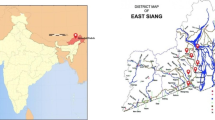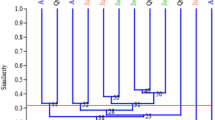Abstract
Pandanus amaryllifolius is cultivated in home gardens in coastal regions of India. Leaves of P. amaryllifolius are scented and exploited commercially by flavour industry. In the present attempt, 40 clonal populations were used for genetic diversity assessment using ISSR and AFLP molecular marker. In ISSR based diversity analysis, out of 38 scorable primers, only one primer showed polymorphism and most of the polymorphic fragments were found in clonal populations from Thailand locality only. In AFLP based diversity analysis all clonal populations from India showed very low genetic distance except Kolkata and Amtala but these populations showed more similarity with Sri Lanka clones and these two localities showed more similarity with Thailand population. Present study confirms that the species has very low level of genetic variation even though it is exposed to a wide range of environmental conditions across peninsular India. Thus, the genome of P. amaryllifolius is said to be highly conserved and remained unaffected through its spread. As per previous report P. amaryllifolius has been introduced in Kolkata, India in 1798 from Indonesia, the similarity is shown by the populations of West Bengal with Thailand population which is close to Indonesia. The populations from Sri Lanka showed similarity with the populations from east and west coast of India suggests that Sri Lanka may be the another source of introduction of P. amaryllifolius in India.





Similar content being viewed by others
References
Ağaoğlu YS, Ergül A, Baydar N (2000) Moleculer analyses of genetic diversity oil rose (Rosa damascena Mill.) grown Isparta (Turkey) region. Biotechnol Biotechnol Equip 14:16–18
Asmain AB (2010) Extracts of the subterranean root from Pandanus amaryllifolius. Dissertation for the Bachelor of Pharmacy, Universiti Teknologi Mara
Balagcod TD, Balangod AKD (2011) Ethnomedical knowledge of plants and healthcare practices among the Kalanguya tribe in Tinoc, Ifugao, Luzon, Philippines. Ind J Tradit Knowl 10(2):227–238
Baydar NG, Baydar H, Debener T (2004) Analysis of genetic relationships among Rosa damascena plants grown in Turkey by using AFLP and microsatellite markers. J Biotechnol 111:263–267. doi:10.1016/j.jbiotec.2004.04.014
Beidler JL, Hilliard PR, Rill RL (1982) Ultrasensitive staining of nucleic acids with silver. Anal Biochem 126(2):374–380. doi:10.1016/0003-2697(82)90530-9
Bhattacharjee P, Kshirsagar A, Singhal RS (2005) Supercritical carbon dioxide extraction of 2-acetyl-1-pyrroline from Pandanus amaryllifolius Roxb. Food Chem 91:255–259. doi:10.1016/j.foodchem.2004.01.062
Bradbury LMT, Fitzgerald TL, Henry RJ, Qing-Sheng J, Waters DLE (2005) The gene for fragrance in rice. Plant Biotechnol J 3:363–370. doi:10.1111/j.1467-7652.2005.00131.x
Bradbury LMT, Gillies SA, Brushett DJ, Waters DLE, Henry RJ (2008) Inactivation of an aminoaldehyde dehydrogenase is responsible for fragrance in rice. Plant Mol Biol 68:439–449. doi:10.1007/s11103-008-9381-x
Bretó MP, Ruiz C, Pina JA, Asins MJ (2001) The diversification of citrus clementina Hort. ex Tan., a vegetatively propagated crop species. Mol Phylogenet Evol 21:285–293. doi:10.1006/mpev.2001.1008
Busque F, March P, Figueredo M, Font J, Sanfeliu E (2002) Total synthesis of four Pandanus alkaloids: pandamarilactonine-A and -B and their chemical precursors norpandamarilactonine-A and -B. Tetrahedron Lett 43:5583–5585. doi:10.1016/S0040-4039(02)01129-2
Buttery RG, Ling LC, Juliano BO (1982) 2-Acetyl-1-pyrroline: an important aroma component of cooked rice. Chem Ind 24(12):958
Buttery RG, Juliano BO, Ling LC (1983) Identification of rice aroma compound 2-acetyl-1-pyrroline in pandan leaves. Chem Ind 23:478
Callaghan TV, Jonsdottir IS, Carlsson S, Svensson BM, Jonasson S (1992) Clonal plants and environmental change: introduction to the proceeding and summaries. Oikos 63:341–347
Che Man YB, Irwandi J, Abdullah WJW (1999) Effect of different types of maltodextrin and drying methods on physicochemical and sensory properties of encapsulated durian flavour. J Sci Food Agric 79:1075–1080
Doyle JJ, Doyle JL (1987) A rapid DNA isolation procedure for small quantities of fresh leaf tissue. Phytochem Bull 19:11–15
Fang DQ, Roose ML (1997) Identification of closely related citrus cultivars with inter simple sequence repeat markers. Theor Appl Genet 95(3):408–417
Jiang J (1999) Volatile composition of pandan leaves (Pandanus amaryllifolius). In: Shadidi F, Ho CT (eds) Flavour chemistry of ethnic foods. Kluwer, New York, pp 105–109
Jong TT, Chau SW (1998) Antioxidative activities of constituents isolated from Pandanus odorattissimus. Phytochemistry 49:2145–2148. doi10.1016/S0031-9422(98)00390-2
Laohakunjit N, Noomhorm A (2004) Supercritical carbon dioxide extraction of 2-acetyl-1-pyrroline and volatile components from pandan leaves. Flavour Fragr J 19:251–259. doi:10.1016/j.foodchem.2004.01.062
McAleece N, Lambshead J, Patterson G, Gage J (1997) BioDiversity Pro, Version 2. The Natural History Museum/The Scottish Association of Marine Science, London/Oban
Nadaf AB, Krishnan S, Wakte KV (2006) Histochemical and biochemical analysis of major aroma compound (2-acetyl-1-pyrroline) in Basmati and other scented rice (Oryza sativa L.). Curr Sci 91(11):1533–1536
Nadaf AB, Wakte KV, Thengane RJ, Jawali N (2008) Review on Pandanus amaryllifolius Roxb.: the plant with rich source of principle basmati aroma compound 2 acetyl-1-pyrroline. Icfai Univ J Biotechnol 2(4):61–76
Nguyen MLT (2006) Insertions and deletions: evolution in the assemblage of Vietnamese food plants. Ethnobot Res Appl 4:175–202
Nor FM, Mohamed S, Idris NA, Ismail R (2008) Antioxidative properties of Pandanus amaryllifolius leaf extracts in accelerated oxidation and deep frying studies. Food Chem 110:319–327. doi:10.1016/j.foodchem.2008.02.004
Ooi LSM, Sun SSM, Ooi VEC (2004) Purification and characterization of a new antiviral protein from the leaves of Pandanus amaryllifolius (Pandanaceae). Int J Biochem Cell Biol 36:1440–1446. doi:10.1016/j.biocel.2004.01.015
Peter KV (2001) Handbook of herbs and spices. Woodhead Publishing Ltd, Cambridge, pp 26–27
Peugvicha P, Thirawarapan SS, Watanabe H (1998) 4-Hydroxybenzoic acid: a hypoglycemic constituent of aqueous extract of Pandanus odorus root II. Jpn J Pharmacol 78:395–398. doi:10.1254/jjp.78.395
Porrarud S, Pranee A (2010) Microencapsulation of Zn-chlorophyll pigment from Pandan leaf by spray drying and its characteristic. IFRJ 17:1031–1042
Ravindran PN, Balachandran I (2005) Underutilized medicinal species-III. Spice India 18(2):16–24
Rayaguru K, Routray W (2011) Microwave drying kinetics and quality characteristics of aromatic Pandanus amaryllifolius leaves. Int Food Res J 18(3):1035–1042
Routray W, Rayaguru K (2010) Chemical constituents and post-harvest prospects of Pandanus amaryllifolius leaves: a review. Food Rev Int 26(3):230–245. doi:10.1080/87559129.2010.484114
Samy J, Sugumaran M, Kate LWL (2005) Herbs of Malaysia: an introduction to the medicinal, culinary, aromatic and cosmetic use of herbs. Federal Publications, Times Editions-Marshall Cavendish, Malaysia, pp 180–181
Sankaranarayanan S, Bama P, Ramachandran J, Kalaichelvan PT, Deccaraman M, Vijayalakshimi M, Dhamotharan R, Dananjeyan B, Sathya Bama S (2010) Ethnobotanical study of medicinal plants used by traditional users in Villupuram district of Tamil Nadu, India. J Med Plant Res 4(12):1089–1101
Stone BC (1978) Studies in Malesian Pandanaceae XVII. On the taxonomy of ‘Pandan Wangi’: a Pandanus cultivar with scented leaves. Econ Bot 32:285–293
Takayama H, Ichikawa T, Kitajima M, Aimi N, Lopez D, Nonato MG (2001) A new alkaloid, pandanamine, finding of an anticipated biogenetic intermediate in Pandanus amaryllifolius. Tetra Lett 42:2995–2996. doi:10.1016/S0040-4039(01)00339-2
Takayama H, Ichikawa T, Kitajima M, Nonato MG, Aimi N (2002) Isolation and structure elucidation of two new alkaloids, pandamarilactonine-C and -D, from Pandanus amaryllifolius and revision of relative stereochemistry of Pandamarilactonine-A and -B by total synthesis. Chem Pharm Bull (Tokyo) 50(9):1303–1304. doi:10.1248/cpb.50.1303
Turner I (2007) Plants for your hair-Henna and company. Gardenwise, The Newsletter of the Singapore Botanic Gardens. 28:36
Uhl S (1995) Emerging flavors of global village-growing demand for ethnic food. Prepared foods. Food & Beverage Industry
Vartak VD (1981) Note on Ambemohar-pat (Pandanus amaryllifolius Roxb.) from western India. J Bombay Nat Hist Soc 78:196–198
Vos P, Hogers R, Bleeker M, Reijans M, Lee T, Hornes M, Frijters A, Pot J, Peleman J, Kuiper M, Zabeau M (1995) AFLP: a new technique for DNA fingerprinting. Nucl Acids Res 23:4407–4414
Wakte KV (2010) Biochemical characterization of aroma volatiles and molecular genotyping in Indian Pandanus amaryllifolius Roxb. clones. Dissertation, University of Pune
Wakte KV, Nadaf AB, Krishnan S, Thengane RJ (2007) Studies on lower epidermal papillae, site of storage of “basmati rice” aroma compounds in Pandanus amaryllifolius Roxb. Curr Sci 93(2):238–242
Wakte KV, Nadaf AB, Thengane RJ, Jawali N (2009a) In vitro regenerating plantlets in Pandanus amaryllifolius Roxb. as a model system to study the development of lower epidermal papillae. In Vitro Cell Dev Biol 45:701–707. doi:10.1007/s11627-009-9191-0
Wakte KV, Nadaf AB, Thengane RJ, Jawali N (2009b) Pandanus amaryllifolius Roxb. cultivated as a spice in coastal regions of India. Genet Resour Crop Evol 56:735–740. doi:10.1007/s10722-009-9431-5
Wakte KV, Thengane RJ, Jawali N, Nadaf AB (2010) Optimization of HS-SPME conditions for quantification of 2-acetyl-1-pyrroline and study of other volatiles in Pandanus amaryllifolius Roxb. Food Chem 121:595–600. doi:10.1016/j.foodchem.2009.12.056
Wakte KV, Zanan RL, Thengane RJ, Jawali N, Nadaf AB (2012) Identification of elite population of Pandanus amaryllifolius Roxb. for higher 2-acetyl-1-pyrroline and other volatile contents by HS-SPME/GC-FID from Peninsular India. Food Anal Methods. doi:10.1007/s12161-012-9373-y
Wyk BEV (2005) Food plants of the world: identification, culinary uses and nutritional value. Times Editions-Marshall Cavendish, Singapore, p 275
Acknowledgments
The research was supported by the financial assistance from Department of Atomic Energy, Board of Research in Nuclear Sciences (Sanction no.: 2006/37/45/BRNS) Mumbai, India.
Author information
Authors and Affiliations
Corresponding author
Rights and permissions
About this article
Cite this article
Wakte, K.V., Zanan, R.L., Saini, A. et al. Genetic diversity assessment in Pandanus amaryllifolius Roxb. populations of India. Genet Resour Crop Evol 59, 1583–1595 (2012). https://doi.org/10.1007/s10722-012-9882-y
Received:
Accepted:
Published:
Issue Date:
DOI: https://doi.org/10.1007/s10722-012-9882-y




